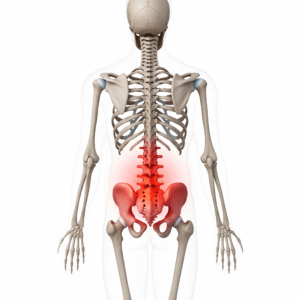
Back Pain Isn’t Just Physical—It’s Personal
Whether it’s a dull ache after a long day at work or a sudden jolt while bending down to pick up a child, back pain—especially lower back pain (lumbar pain)—can disrupt your entire day. If you’re one of the millions silently wincing while tying your shoes or sitting too long, this post is for you.
Let’s talk honestly and practically about back pain: what causes it, how it affects your life, and most importantly, what you can do about it.
What Exactly Is Back Pain?
Back pain can refer to discomfort anywhere along the spine, but most commonly, people experience it in the lower back, or lumbar region. It can be sharp, throbbing, stiff, or even radiating down your legs. Some feel it only after physical exertion, while others wake up with it every morning.
Common Causes Include:
- Poor posture (especially from sitting too long)
- Sedentary lifestyle
- Lifting heavy objects incorrectly
- Herniated discs or degenerative disc disease
- Stress and anxiety (yes, your back carries emotional weight too)
- Pregnancy or hormonal changes
- Old injuries or muscle imbalances
You’re Not Alone: The Emotional Side of Back Pain
Back pain isn’t just about bones and muscles—it’s about your life. The inability to play with your kids, work productively, or simply enjoy a night’s sleep can take a toll on your mental health, relationships, and confidence. You’re not lazy or broken. You’re living with something that deserves real care—not just quick fixes.
Natural and Effective Back Pain Management
If you’re tired of relying on painkillers or temporary patches, here are evidence-based and practical solutions that actually help:
1. Gentle Movement Over Complete Rest
Many people believe they should lie down all day when their back hurts. But research shows that gentle mobility exercises, like walking or stretching, actually help increase blood flow and reduce stiffness.
2. Correct Your Posture—Without the Guilt
Sitting hunched over a laptop? It’s okay—it happens. Try small changes like:
- Using a lumbar cushion
- Keeping your feet flat on the floor
- Taking a standing break every 30–45 minutes
3. Strengthen Your Core (Not Just Abs)
Your core muscles support your spine. Try incorporating low-impact exercises like planks, bridges, or Pilates into your routine.
4. Heat and Cold Therapy
- Cold can reduce inflammation within the first 48 hours.
- Heat can relax tight muscles after that.
5. Mind-Body Techniques
Your body holds tension—especially your back. Practices like yoga, deep breathing, and guided meditation can ease both physical and emotional pain.
Everyday Habits That Prevent Future Back Pain
- Sleep on a supportive mattress
- Lift with your legs, not your back
- Maintain a healthy weight
- Hydrate to keep spinal discs healthy
- Don’t ignore stress—your back feels it
Final Thoughts: Your Back Deserves Better
Back pain may be common, but it shouldn’t be your normal. Whether you’re a parent carrying toddlers, a student buried in textbooks, or someone with a physically demanding job—your back carries a lot.
It’s okay to slow down. It’s okay to ask for help. And it’s definitely okay to prioritize your comfort and recovery.
When to See a Doctor
If your pain:
- Lasts more than 2 weeks
- Is accompanied by numbness or tingling
- Follows a fall or injury
- Causes leg weakness
- Is unrelenting, especially at night
Don’t delay. Some issues like herniated discs or spinal stenosis need professional evaluation and care.
Need a routine that works for your lifestyle? Subscribe to our blog for weekly tips on managing back pain naturally—because healing starts with knowledge.

